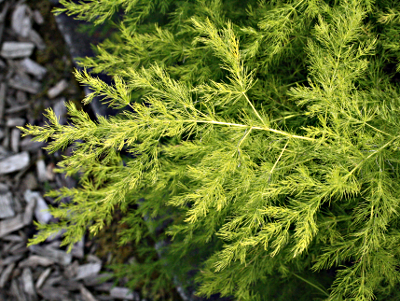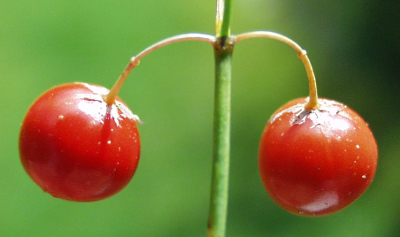Asparagoideae |

The climbing asparagus (Asparagus verticillatus)

The fruits oft the Asparagoideae are often berries
The genus Dracaena now belongs to the Nolinoideae, it entered another genus in its place: Hemiphylacus - a taxon of Mexican plants with a bulbous-like rhizome that includes 5 species.
Comprising about 160 to 300 species, the subfamily occurs naturally in the temperate zones of Eurasia, in Africa and in Mexico. By the garden asparagus and some ornamental plants it has spread across all continents. The plants are hermaphrodite or dioecious, perennial herbs, subshrubs, shrubs or vines with a mostly short rhizome.
The upright or twining stems are usually branched at least above. The inconspicuous, membranous, scaly leaves are densely attached to the stem. In Asparagus they contain no chlorophyll and have a spurred base, the spurs may leak into spines. From the leaf axils arise bundles of acicular phylloclades, (lateral shoots, have taken over leaf functions and are often confused with leaves) rarely they are solitary. Hemiphylacus has no phylloclades - the photosynthesis is carried out by basal, parallel veined and broad linear leaves.
The hermaphrodite or unisexual flowers are united in axillary clusters or terminal in racemes or umbrellas or they occur individually or in pairs. The flower stems of Asparagus are structured into two parts. They are surrounded by a membranous bract. In Hemiphylacus the inflorescences are covered by two leathery bracts at the branches.
The 6 identical looking, whitish, greenish or yellowish petals are free, united just at the base or up to half and form a bell-shaped to almost globular flower. The 6 stamens are often grown together with the petals. In Hemiphylacus three of them are sterile (staminodes). The superior ovary consists of 3 carpels. After insect pollination 1- to 6-seeded berries (Asparagus) or leathery, ovate to broadly triangular capsule with 3–6 seeds (Hemiphylacus) are formed.
| Floral formula mostly: |
| * [P3+3 A3+3] G(3) superior |
Interesting notes
- The genera Asparagus and Hemiphylacus look out completely unlike, apparent similarities show only the flowers and the structures of the ovules.